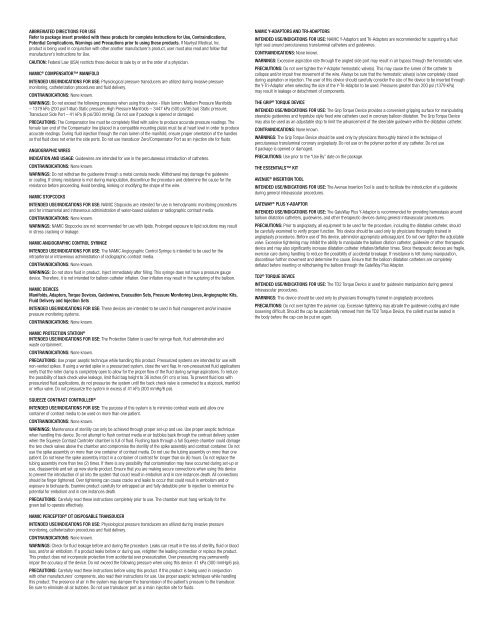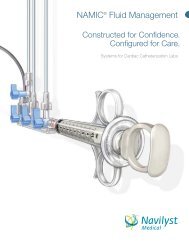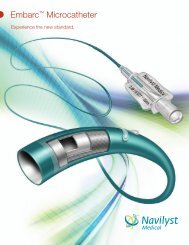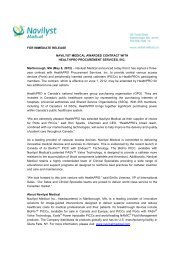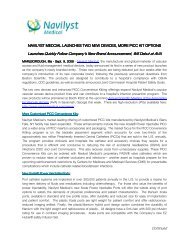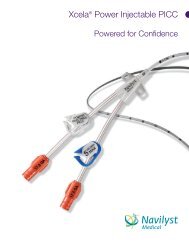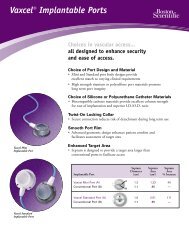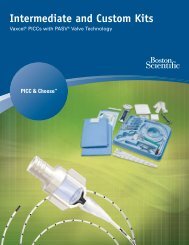Fluid Management Catalog - Navilyst medical
Fluid Management Catalog - Navilyst medical
Fluid Management Catalog - Navilyst medical
Create successful ePaper yourself
Turn your PDF publications into a flip-book with our unique Google optimized e-Paper software.
ABBREVIATED DIRECTIONS FOR USERefer to package insert provided with these products for complete Instructions for Use, Contraindications,Potential Complications, Warnings and Precautions prior to using these products. If <strong>Navilyst</strong> Medical, Inc.product is being used in conjunction with other another manufacturer’s product, user must also read and follow thatmanufacturer’s Instructions for Use.CAUTION: Federal Law (USA) restricts these devices to sale by or on the order of a physician.NAMIC ® COMPENSATOR MANIFOLDIntended Use/Indications for Use: Physiological pressure transducers are utilized during invasive pressuremonitoring, catheterization procedures and fluid delivery.Contraindications: None known.WARNINGS: Do not exceed the following pressures when using this device - Main lumen: Medium Pressure Manifolds– 1379 kPa (200 psi/14bar) Static pressure; High Pressure Manifolds – 3447 kPa (500 psi/35 bar) Static pressure;Transducer Side Port – 41 kPa (6 psi/300 mmHg). Do not use if package is opened or damaged.PRECAUTIONS: The Compensator line must be completely filled with saline to produce accurate pressure readings. Thefemale luer end of the Compensator line (placed in a compatible mounting plate) must be at heart level in order to produceaccurate readings. During fluid injection through the main lumen of the manifold, ensure proper orientation of the handlesso that fluid does not enter the side ports. Do not use transducer Zero/Compensator Port as an injection site for fluids.ANGIOGRAPHIC WIRESINDICATION AND USAGE: Guidewires are intended for use in the percutaneous introduction of catheters.CONTRAINDICATIONS: None known.WARNINGS: Do not withdraw the guidewire through a metal cannula needle. Withdrawal may damage the guidewireor coating. If strong resistance is met during manipulation, discontinue the procedure and determine the cause for theresistance before proceeding. Avoid bending, kinking or modifying the shape of the wire.NAMIC STOPCOCKSINTENDED USE/INDICATIONS FOR USE: NAMIC Stopcocks are intended for use in hemodynamic monitoring proceduresand for intraarterial and intravenous administration of water-based solutions or radiographic contrast media.Contraindications: None known.Warnings: NAMIC Stopcocks are not recommended for use with lipids. Prolonged exposure to lipid solutions may resultin stress cracking or leakage.NAMIC Angiographic Control SyringeIntended Use/Indications for Use: The NAMIC Angiographic Control Syringe is intended to be used for theintraarterial or intravenous administration of radiographic contrast media.Contraindications: None known.Warnings: Do not store fluid in product. Inject immediately after filling. This syringe does not have a pressure gaugedevice. Therefore, it is not intended for balloon catheter inflation. Over inflation may result in the rupturing of the balloon.NAMIC DevicesManifolds, Adaptors, Torque Devices, Guidewires, Evacuation Sets, Pressure Monitoring Lines, Angiographic Kits,<strong>Fluid</strong> Delivery and Injection SetsIntended Use/Indications for Use: These devices are intended to be used in fluid management and/or invasivepressure monitoring systems.Contraindications: None known.NAMIC Y-Adaptors and Tri-AdaptorsIntended Use/Indications for Use: NAMIC Y-Adaptors and Tri-Adaptors are recommended for supporting a fluidtight seal around percutaneous transluminal catheters and guidewires.Contraindications: None known.Warnings: Excessive aspiration rate through the angled side port may result in air bypass through the hemostatic valve.Precautions: Do not over tighten the Y-Adaptor hemostatic valve(s). This may cause the lumen of the catheter tocollapse and/or impair free movement of the wire. Always be sure that the hemostatic valve(s) is/are completely closedduring aspiration or injection. The user of this device should carefully consider the size of the device to be inserted throughthe Y-Tri-Adaptor when selecting the size of the Y-Tri-Adaptor to be used. Pressures greater than 200 psi (1379 kPa)may result in leakage or detachment of components.The Grip ® Torque DeviceIntended Use/Indications for Use: The Grip Torque Device provides a convenient gripping surface for manipulatingsteerable guidewires and hypotube style fixed wire catheters used in coronary balloon dilatation. The Grip Torque Devicemay also be used as an adjustable stop to limit the advancement of the steerable guidewire within the dilatation catheter.Contraindications: None known.Warnings: The Grip Torque Device should be used only by physicians thoroughly trained in the technique ofpercutaneous transluminal coronary angioplasty. Do not use on the polymer portion of any catheter. Do not useif package is opened or damaged.Precautions: Use prior to the “Use By” date on the package.The Essentials KitAvenue ® Insertion ToolIntended Use/Indications for Use: The Avenue Insertion Tool is used to facilitate the introduction of a guidewireduring general intravascular procedures.Gateway ® Plus Y-AdaptorIntended Use/Indications for Use: The GateWay Plus Y-Adaptor is recommended for providing hemostasis aroundballoon dilatation catheters, guidewires, and other therapeutic devices during general intravascular procedures.Precautions: Prior to angioplasty, all equipment to be used for the procedure, including the dilatation catheter, shouldbe carefully examined to verify proper function. This device should be used only by physicians thoroughly trained inangioplasty procedures. Before use of this device, administer appropriate anticoagulant. Do not over tighten the adjustablevalve. Excessive tightening may inhibit the ability to manipulate the balloon dilation catheter, guidewire or other therapeuticdevice and may also significantly increase dilatation catheter inflation/deflation times. Since therapeutic devices are fragile,exercise care during handling to reduce the possibility of accidental breakage. If resistance is felt during manipulation,discontinue further movement and determine the cause. Ensure that the balloon dilatation catheters are completelydeflated before inserting or withdrawing the balloon through the GateWay Plus Adaptor.TD2 ® Torque DeviceIntended Use/Indications for Use: The TD2 Torque Device is used for guidewire manipulation during generalintravascular procedures.Warnings: This device should be used only by physicians thoroughly trained in angioplasty procedures.Precautions: Do not over tighten the polymer cap. Excessive tightening may abrade the guidewire coating and makeloosening difficult. Should the cap be accidentally removed from the TD2 Torque Device, the collett must be seated inthe body before the cap can be put on again.NAMIC Protection Station ®Intended Use/Indications for Use: The Protection Station is used for syringe flush, fluid administration andwaste containment.Contraindications: None known.Precautions: Use proper aseptic technique while handling this product. Pressurized systems are intended for use withnon-vented spikes. If using a vented spike in a pressurized system, close the vent flap. In non-pressurized fluid applicationsverify that the roller clamp is completely open to allow for the proper flow of the fluid during syringe aspirations. To reducethe possibility of back check valve leakage, limit fluid bag height to 36 inches (91 cm) or less. To prevent fluid loss withpressurized fluid applications, do not pressurize the system until the back check valve is connected to a stopcock, manifoldor reflux valve. Do not pressurize the system in excess of 41 kPa (300 mmHg/6 psi).Squeeze Contrast Controller ®Intended Use/Indications for Use: The purpose of this system is to minimize contrast waste and allow onecontainer of contrast media to be used on more than one patient.Contraindications: None known.Warnings: Maintenance of sterility can only be achieved through proper set-up and use. Use proper aseptic techniquewhen handling this device. Do not attempt to flush contrast media or air bubbles back through the contrast delivery systemwhen the Squeeze Contrast Controller chamber is full of fluid. Flushing back through a full Squeeze chamber could damagethe two check valves above the chamber and compromise the sterility of the spike assembly and contrast container. Do notuse the spike assembly on more than one container of contrast media. Do not use the tubing assembly on more than onepatient. Do not leave the spike assembly intact in a container of contrast for longer than six (6) hours. Do not replace thetubing assembly more than two (2) times. If there is any possibility that contamination may have occurred during set-up oruse, disassemble and set up new sterile product. Ensure that you are making secure connections when using this deviceto prevent the introduction of air into the system that could result in embolism and in rare instances death. All connectionsshould be finger tightened. Over tightening can cause cracks and leaks to occur that could result in embolism and orexposure to biohazards. Examine product carefully for entrapped air and fully debubble prior to injection to minimize thepotential for embolism and in rare instances death.Precautions: Carefully read these instructions completely prior to use. The chamber must hang vertically for thegreen ball to operate effectively.NAMIC Perceptor ® DT Disposable TransducerIntended Use/Indications for Use: Physiological pressure transducers are utilized during invasive pressuremonitoring, catheterization procedures and fluid delivery.Contraindications: None known.Warnings: Check for fluid leakage before and during the procedure. Leaks can result in the loss of sterility, fluid or bloodloss, and/or air embolism. If a product leaks before or during use, retighten the leading connection or replace the product.This product does not incorporate protection from accidental over pressurization. Over pressurizing may permanentlyimpair the accuracy of the device. Do not exceed the following pressure when using this device: 41 kPa (300 mmHg/6 psi).Precautions: Carefully read these instructions before using this product. If this product is being used in conjunctionwith other manufacturers’ components, also read their instructions for use. Use proper aseptic techniques while handlingthis product. The presence of air in the system may dampen the transmission of the patient’s pressure to the transducer.Be sure to eliminate all air bubbles. Do not use transducer port as a main injection site for fluids.


